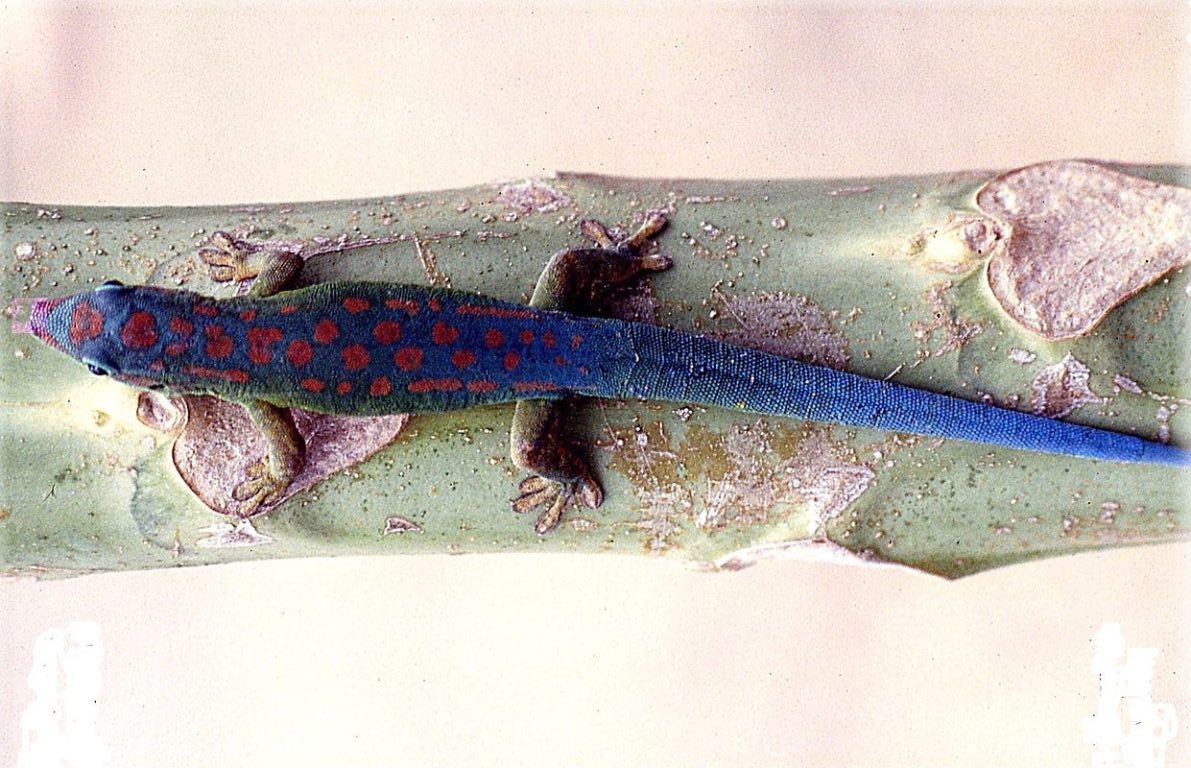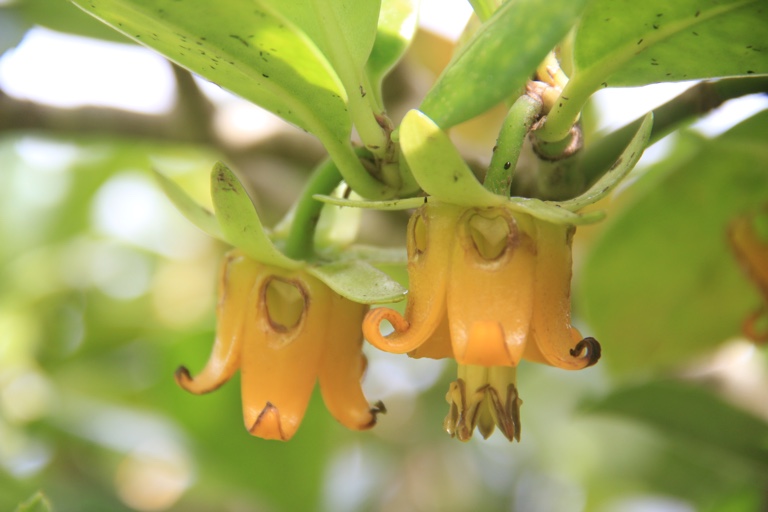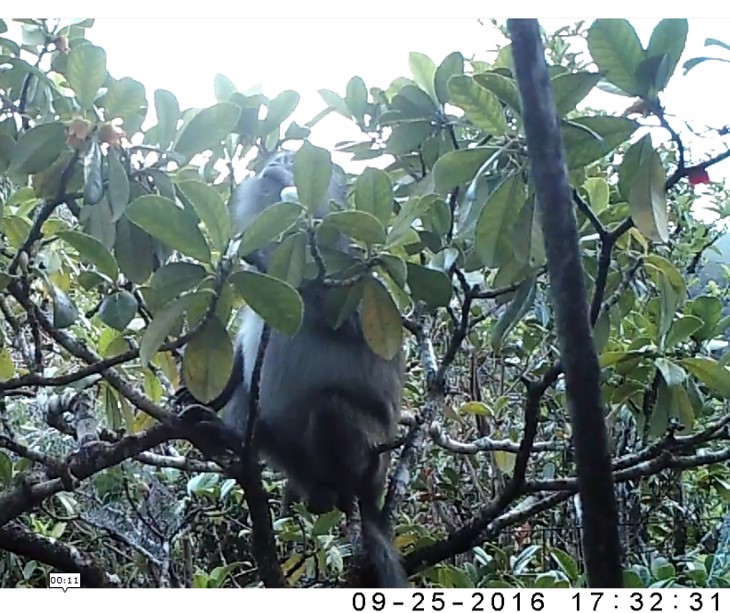- Roussea simplex, a unique plant that grows only on the mountains of Mauritius, is the only species in its genus, with just 250-odd individuals remaining in the wild.
- Prishnee Bissessur, a graduate student at the University of Mauritius who has been studying the plant since 2015, has “radically changed what was known of the plant’s ecology so far,” according to one ecologist.
- Mongabay spoke with Bissessur to learn about her work on Roussea simplex, what makes the plant so fascinating, and the challenges of studying it.
The plant Roussea simplex, usually referred to by its scientific name, is one of a kind. It grows only in the mountains of the Indian Ocean island of Mauritius; it’s the only species in the genus Roussea; and the only species in the entire subfamily Rousseoideae. It’s also down to just 250-odd individuals in the wild, which means that most people will likely never encounter it in their lifetime. For Prishnee Bissessur, it was love at first sight.
Before 2014, though, Bissessur had never climbed a Mauritian mountain and never seen the plant. But prodded by her professor at the University of Mauritius, who was hoping she would study the rare plant, she hiked up the thumb-shaped Le Pouce mountain in the northwest of the tiny island to see what the fuss was all about. Close to the summit, R. simplex, a plant with woody vines that scramble atop other trees, was in bloom, displaying its pendulous yellow flowers in full glory. “They were so beautiful that anyone who would see them would fall in love,” Bissessur told Mongabay.
Falling in love was one thing, but when Bissessur went back and started digging into the scientific literature on the species, she quickly realized that the plant was more complicated than she’d anticipated. “It’s called Roussea simplex, but it’s more like Roussea complex,” she said.
Now a graduate student at the University of Mauritius, Bissessur has been slowly unraveling R. simplex’s mysteries. Her research has even overturned some of the more well-known aspects of the species, named after the philosopher Jean-Jacques Rousseau. For instance, for a long time the plant was thought to have just one specialized pollinator and seed disperser: the blue-tailed day gecko (Phelsuma cepediana), a lizard found nowhere else on Earth. But by placing camera traps around the plants, Bissessur’s research showed that the gecko has company, including the Mauritius bulbul (Hypsipetes olivaceus), a bird known only from the island.
Her work has also shown that invasive alien ants, previously believed to be a major threat to the plants because they disrupt pollination by the geckos, aren’t as big a menace.
“The many findings made with the PhD studies of Prishnee has radically changed what was known of the plant’s ecology so far,” Vincent Florens, an associate professor of ecology at the University of Mauritius, told Mongabay. “It has also equipped us with a much better understanding of the drivers of the species’ decline, which is already informing more impactful conservation.”

Both Florens and Bissessur see R. simplex, locally known as Liane Rousseau, as more than a single species in peril. They say that it will serve as a model species to understand other island plants and the threats that plague them.
“I am confident that the story of Roussea can serve more widely as a good example of the fascinating and important discoveries that can be made about a species’ natural history through painstaking yet relatively simple field observation and experimental approaches,” Florens said.
However, plants, especially those without any known medicinal value, are challenging to study. There’s very little funding, Bissessur said, and few people want to help during the field work.
Mongabay recently spoke with Bissessur to learn about her work on R. simplex, what makes the plant so fascinating, and the challenges of studying it. The following interview has been edited for length and clarity.
Mongabay: Could you tell us a bit about the plant itself?
Prishnee Bissessur: Roussea simplex is a really slow-growing plant that’s epiphytic [grows on the surface of other plants for physical support, not food] and it scrambles, growing into dense canopy. It is protandrous, which means that its flowers transition from male to female. It has sticky pollen and it produces quite a lot of nectar. It flowers all year round, but there are two flowering peaks, one during July to December and then April to June.
So if one were to see them in a forest would they be easily identifiable?
Yes, very much so. They are shrubs and don’t look like trees. And there are not many similar-looking plants in Mauritius. If it’s flowering, you can definitely not miss it.

People are usually interested in animals. What is it about Roussea that fascinated you the most?
When you think of it, in terms of the food web, it’s mostly the plants that are at the base, and then you narrow it up to the top predators. For me, studying plants was always interesting because animals depend on plants. And it was not just the plant itself but all the interactions that come with it that was interesting. Roussea is unique in the sense that it was discovered that it’s pollinated by the endemic gecko, and it was also one of the first plants to be discovered with double mutualism; that is, it was considered to be pollinated by the gecko and seed dispersed by the gecko as well. Also, we’re using Roussea as a model island plant. The idea is to use Roussea to identify threats that are causing it to decline and show how by systematically studying the lifestyle stages of a plant you can actually pinpoint where the problem lies, and address them. Because other island plants are also facing similar threats, the results from Roussea are applicable to them as well.
Where can one find Roussea simplex?
Both the genus Roussea and the family Rousseacea to which Roussea simplex belongs are endemic to Mauritius, so you can’t find them anywhere else on Earth. In Mauritius, Roussea is currently found in only nine locations, mostly concentrated in the southwest and northwest of the island.
Finding where it’s now located was the first part of my study. I did a thorough literature review to look for mentions of sightings and locations of Roussea. I also spent a lot of time looking at herbarium specimens and collated information on Roussea’s distribution from those. In the end, we retrieved 18 locations. We did field work to check if the populations were still there, but we were able to retrace only nine of them. So there’s been almost a 50 percent decline in the distribution over the last 250 years. And for the last 20 years, there has been drastic decrease in their population size.
In 2004, Dennis Hansen [of the Institute of Environmental Sciences at the University of Zurich in Switzerland] reported that there were only 85 to 90 individuals left, but we did a more comprehensive study. For now, we estimate there are around 250 individuals on the whole island. But the population trend is still constantly declining. If we were to Red List it according to IUCN, it would be considered as endangered.
Where are the nine locations where Roussea simplex can still be found?
About 95 percent of the plants occur in protected areas, that is, nature reserves, national parks, and mountain reserves at high elevations. But only one of the sites, a conservation management area, is currently being actively managed. So the managers do active weed control, and the area is fenced.
What are some unusual tools you’ve used to study Roussea?
So the most interesting one, I think, is the Bushnell trail camera. I wanted to look at animals that visit Roussea flowers because the only reported ones were the grey white-eye [Zosterops mauritianus] and the Phelsuma geckos. But the Bushnell cameras revealed interactions that had not been observed earlier, and which we would have missed. For example, black rats are a big problem for Roussea. They are eating a lot of these flowers. They usually make holes at the base of the flower to get to the nectar and even chop whole flowers. That’s one of the interactions that I’m going to study next. But they are nocturnal and we wouldn’t have seen them in action if there were no camera there. We also caught monkeys [long-tailed macaques, Macaca fascicularis] on the cameras.
If you sit and observe the plants, it can probably change the behavior of animals. The cameras helped us to do it in a way such that the animal was not aware that it was being observed. For my next study, I’m going to use rat traps to see if controlling rats has an impact on flower production.


You found that the blue-tailed day gecko is not the only pollinator of Roussea as previously thought. Could you tell us about some of your findings?
[Using camera traps, Bissessur and team found that Roussea flowers were visited by three endemic birds — the Mauritius bulbul, the grey white-eye, and the olive white-eye, Zosterops chloronothos — as well as two endemic reptiles: the blue-tailed day gecko and the ornate day gecko, Phelsuma ornata. Three species not native to the island, the long-tailed macaque, red-whiskered bulbul and the black rat, visited the flowers too.]
We found that the Mauritius bulbul visits the flowers quite frequently and on camera footage we could see that the bulbul could carry pollen, which is quite sticky, on its beak. What we did was to see whether it could be a more efficient pollinator than the gecko because it’s a bird, so it can fly to longer distances and do cross-pollination of the plant. We carried out a series of experiments including pollinator exclusion experiments. For the latter, we used three treatments: we placed metallic cages around some flowers to exclude the birds, giving only geckos access to the flowers; we bagged some flowers with nylon bags, so neither gecko nor the bird could have access to the flowers; and some of flowers were left completely open for both pollinators to access. Then we looked at the seed set of fruits that developed post these three different treatments.
In the end, we found that the bulbul was a more efficient pollinator than the gecko.
Interestingly, Hansen and Müller showed that when the great white-eye, which is a smaller bird and has a short beak, goes into a flower for nectar, the pollen sticks to the bird’s feathers on its head. When it then goes from flower to flower, it is not able to transfer the pollen. But the Mauritius bulbul has a longer beak, so the pollen is deposited on the beak instead of the feathers, and when it goes from flower to flower, it can actually deliver the pollen successfully.

You have also been looking at threats to Roussea from invasive alien ants. Could you talk about that?
Hansen and Müller showed that these ants infest the flowers for nectar, and they make these ant galleries around the flower in the corolla. So when the ants are present, the geckos don’t visit the flowers. And due to lower frequency of visits by the geckos, there’s lower pollination, and then lower seed sets. What I was interested to see is whether this disruption is something that occurs all year round, or it varies through time, and across sites.
I looked at around 1,468 flowers over two consecutive years, and I found that a very low number of flowers were actually infested by ants — only 6 percent of the flowers. And most of the infested flowers were found below one-meter [3 feet] height. So what we find is that when there are invasive plants like strawberry guava (Psidium cattleyanum) and Clidemia hirta [commonly called soapbush], Roussea collapses to the ground, and this makes it more accessible to the ant.
Why does the presence of invasive plants cause Roussea to move closer to the ground?
Roussea is epiphytic, so when the host tree has to compete with other invasive plants, and it dies, Roussea just collapses to the ground as well.
So far, it had been shown that ants are a big problem for Roussea. But it seems like their effect is quite negligible. Instead, when you look at the bigger picture, it’s actually invasion by alien plants that is having a bigger impact. I’m now looking at the competition between Roussea and invasive plants.

What are some of the biggest challenges in studying Roussea? And is it hard to get funding?
I presume that’s one of the problems of every researcher, but I think for those working on plants, it’s even more challenging because we are not working with charismatic animals like big cats, or cute mammals. My research is partly funded by Mauritius Research Council, but it covers only tuition fees. The rest is all self-funded. I even tried crowdfunding for the rat control study because I had to buy camera traps and rat traps, but so far it’s been funded 12 percent.
One of the challenges I face when talking about my plant is that the very first question I get is, “Does it have any medicinal properties?” Or, “Does it cure cancer?” So people are always looking at what the plant can give.
It’s also challenging to do field work because it’s quite hard to find assistants or people who can go with me. So, I end up having to rely mostly on family and some friends who can spare some time to accompany me because it’s quite dangerous to go alone.
In terms of Roussea, because I have nine locations to work with, I’m quite restricted in terms of where I can set up experiments and my sample sizes, but you can always explain that because there are very few individuals left. So you make do with what you have.
How do you think your research can help in the conservation of Roussea?
At the end of the study, we will come up with conservation measures to propose to conservation managers. Some of those are very basic in terms of control of invasive plants, or translocation of pollinators like the bulbul to habitats where they are locally extinct. But what I would suggest is to not do micromanagement, because in the case of rare species, while micromanagement can be useful in the short term, it is very unsustainable in the long run. For our case, management would be addressing the invasion of alien plants, and rat control. But you’ll also need to do constant monitoring to see if the conservation measures that have been put in place are still working, or if they need some revision.
At the end, we will pose some solutions to conservation managers, but it’s not only going to benefit Roussea itself, it’s going to benefit all the surrounding native plants equally.
